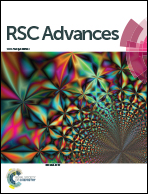The green synthesis of a palm empty fruit bunch-derived sulfonated carbon acid catalyst and its performance for cassava peel starch hydrolysis
Abstract
A sulfonated carbon acid catalyst (C–SO3H) was successfully generated from palm empty fruit bunch (PEFB) carbon via hydrothermal sulfonation via the addition of hydroxyethylsulfonic acid and citric acid. The C–SO3H catalyst was identified as containing 1.75 mmol g−1 of acid and 40.2% sulphur. The surface morphology of C–SO3H shows pores on its surface and the crystalline index (CrI) of PEFB was decreased to 63.8% due to the change structure as it became carbon. The surface area of the carbon was increased significantly from 11.5 to 239.65 m2 g−1 after sulfonation via hydrothermal treatment. The identification of –SO3H, COOH and –OH functional groups was achieved using Fourier-transform infrared spectroscopy. The optimal catalytic activity of C–SO3H was achieved via hydrolysis reaction with a yield of 60.4% of total reducing sugar (TRS) using concentrations of 5% (w/v) of both C–SO3H and cassava peel starch at 100 °C for 1 h. The stability of C–SO3H shows good performance over five repeated uses, making it a good potential candidate as a green and sulfonated solid acid catalyst for use in a wide range of applications.



 Please wait while we load your content...
Please wait while we load your content...